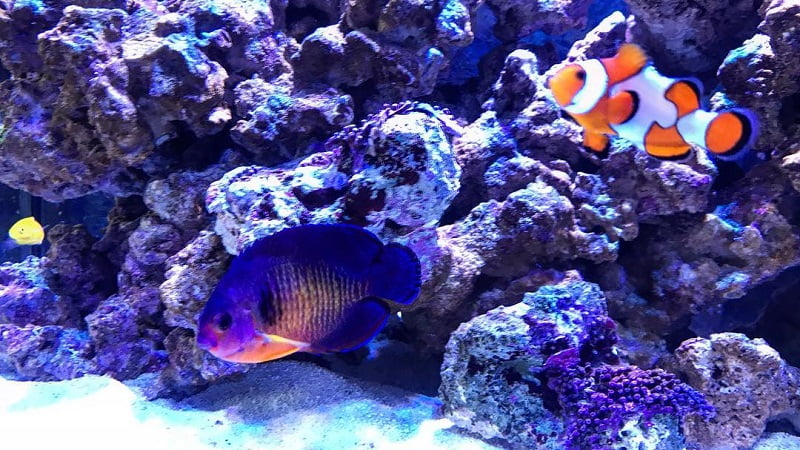Coral beauty angelfish are generally easy-going with other fish as long as they are well-fed and have enough swimming space.
They will express aggression toward the same fish in their species. Their territorial behavior will become more intense when two males of the same coral beauty species are paired together.
Therefore, they can get along with other calm, semi-aggressive, and aggressive fish genera. This article will provide you with a list of the 15 best coral beauty angelfish tank mates. I hope this list will help you find your favorite fish compatible with your coral beauty angels.
Related Post Coral Beauty Angelfish Best Profile: Habitat, Size, Behavior, Lifespan, Diet, Breeding & More
Peaceful Coral Beauty Angelfish Tank Mates
Gobies
Gobies are the fish community belonging to the Gobiidae family. These marine creatures usually have small sizes, are carnivorous, and can be found worldwide, especially along shores and reefs in the tropical oceans. Most gobies are bottom-dwellers whose pelvic fins fuse to form a thin suction cup.
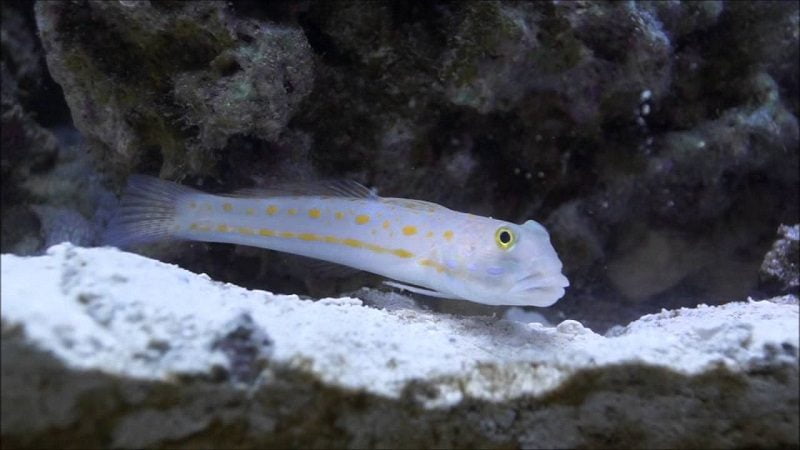
Most marine gobies can fully grow to 10 cm (4 inches). Some species can be smaller, such as the Philippine Pandaka pygmaea with an adult size of less than about 13 mm (3/8 inch).
The most popular gobies in captivity are the colorful neon gobies. Most gobies hide in the rockwork of the lower portion of the aquarium, but some species (most notably shrimp gobies) dig burrows for themselves.
The majority of gobies are very happy in a tank having a significant amount of rocks and live sand available for them to hide in.
When first added, gobies can be pretty shy and hide out, so it will not be a big deal if you will not see them for a few days. Gobies are the genus that often commands their territory. Therefore, they may spend time determining the layout of the tank and selecting their territories.
Dartfish
Dartfish, also called firefish, wormfish, and ribbon goby fish, are small saltwater fish with extremely colorful bodies. They come in a variety of colors, such as red, yellow, orange, blue, purple, green, and black.
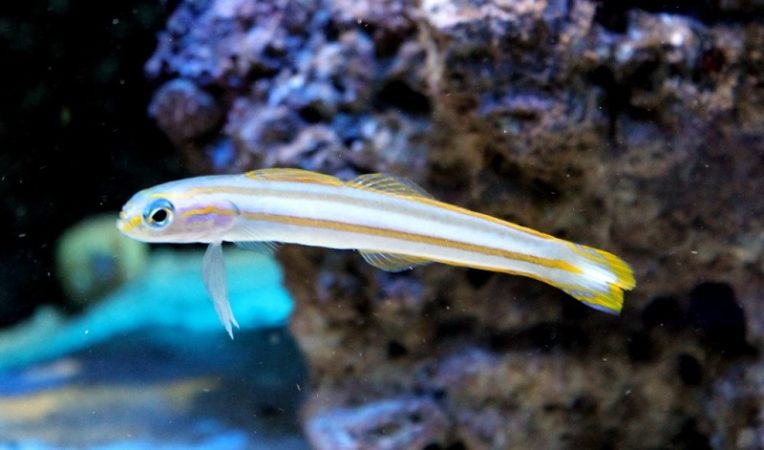
A variety of dartfish species can adapt quickly to aquarium conditions and are quite hardy. For this reason, they can be a good choice for aquarists of any experience level.
A 25-gallon tank is a minimum size recommended for keeping a dartfish. However, it prefers to be in a group of at least 4 specimens, meaning larger tanks are the best option to go for.
For tank setup, these fish require a tank with a large number of hiding places and at least 2 inches of substrate to burrow in. As dartfish are good jumpers, you should have a tight-fitting canopy on your home aquarium.
Assessors
Assessors are the genus of ray-finned fishes found in the western Pacific Ocean from Japan to Australia. They can grow up to 3.5″ in length.
There are three species in this fish genus, including Assessor macneilli (the blue devilfish), Assessor flavissimus (the yellow devilfish), and Assessor randalli (Randall’s assessor or Randall’s devilfish).
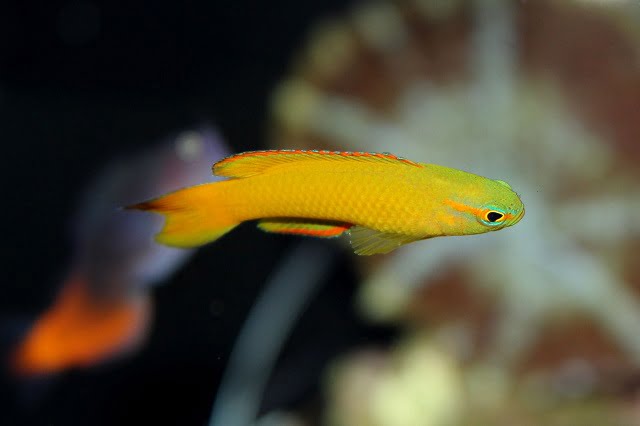
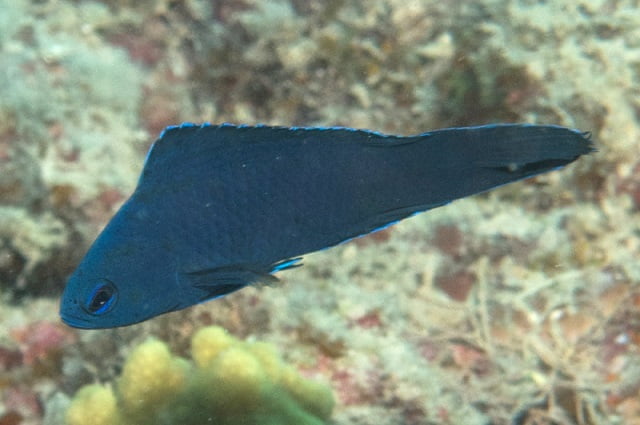
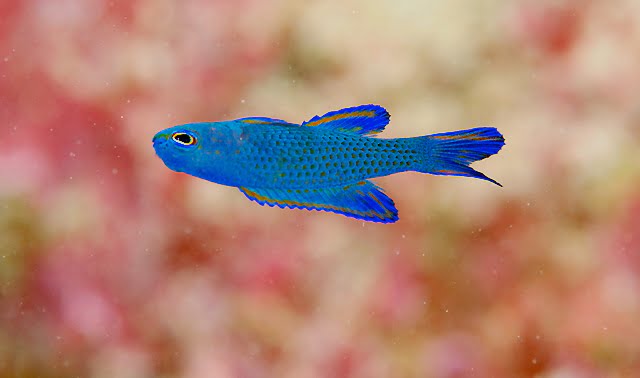
As planktivores, they do not have very particular dietary preferences. The newly-acquired assessors should be fed frozen mysis or cyclops before they are weaned onto dry foods. Daily feeding is recommended for keeping them healthy.
They often do not display aggressive behaviors towards other fish but their own species. Other small reef fish are also not their concern.
Assessors are compatible with nearly any reef tank. They require some live rock for cover and can cope with most light, temperature, and flow conditions.
Since they grow very slowly, small specimens can be kept in nano-reefs, but once they are large enough, they will need to be moved into larger tanks. A 29-gallon tank should be comfortable for an adult since they aren’t particularly active swimmers.
Fairy wrasses
Fairy wrasses inhabit the Red Sea through the Indian Ocean and across the Pacific Ocean to the Pitcairn Islands, all the way to Hawaii and Japan. They normally hang over coral mounds and soft corals, hiding from predators and feeding on zooplanckton just above the surface.
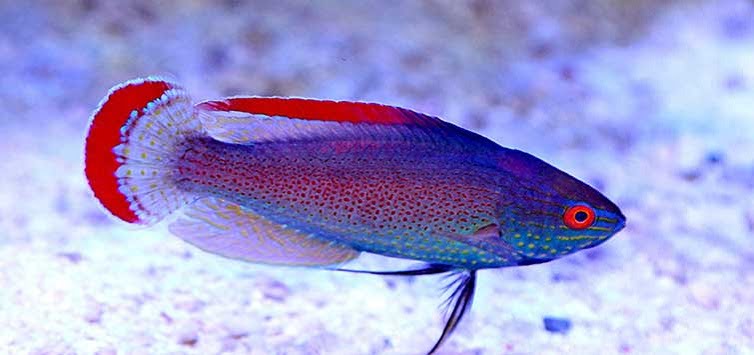
Typically, the fairy wrasse grows up to the size of 6 inches and lives for about five to eight years.
The fairy wrasse is an outgoing species that does not need to go in schools. However, you should be cautious when adding two males of the same fairy wrasses species because they tend to get territorial.
As they can frighten easily and are good jumpers, the aquarium canopy must be enclosed completely.
Fairy wrasses are all small and active fish, so they do need more space to dart around. An aquarium must be at least four feet long, but the bigger the aquarium, the healthier the fish.
It is possible to mix fairy wrasses but is best done in a large aquarium. A 55-gallon tank is a minimum size for keeping a single fairy wrasse. Aquariums with a capacity of >300 gallons can safely keep several fairy wrasses species.
You should provide plenty of hiding areas and add plenty of live rock to the tank since they need places to hide from other fish.
Semi-Aggressive Tank Mates
Anthias
Anthias are found on coral reefs throughout the eastern Atlantic Ocean and the Mediterranean Sea.
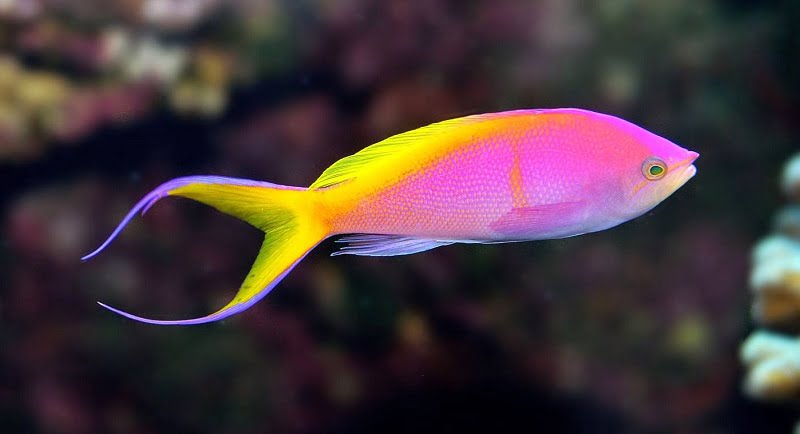
The majority of anthias fish species are relatively hardy but require food frequently to thrive in a home aquarium. Anthias have a complex social structure, meaning that keeping one species per tank is the best option.
Also, Anthias prefer longer tanks, where they can stretch out their fins. An aquarium at least 4 feet in length would be adequate. Random flow patterns and vigorous water movement would be helpful to keep your fish happy.
For keeping several anthias together, it is recommended to mix one male with several females.
The best foods for anthias once they have been introduced to an aquarium are frozen mysis shrimps and frozen brine shrimps. Over time, they may eat flake food in small quantities.
Clown anemonefish (Clownfish)
The clown anemonefish, also known as the captive-bred percula clownfish or the True Percula, is generally found on the reefs of Oceania, the Indo-Pacific, and the Great Barrier Reef. It may be found individually or commonly in pairs or small groups of the same species.
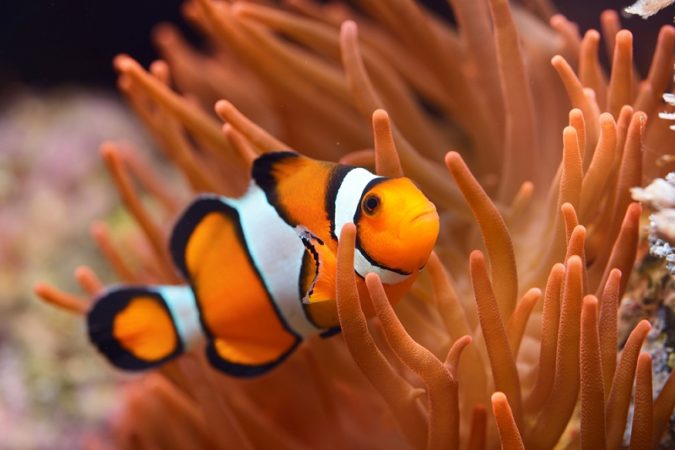
When young, these species of clownfish are usually orange and white. As they grow, the black areas between the white stripes become darker.
Clown anemonefish have a maximum size of 3 inches and require a minimum tank size of 30 gallons. They are also hardy fish and can adapt to a variety of conditions in your home aquarium.
This clownfish species is omnivorous in nature. In captivity, you can feed it meaty foods or herbivorous preparations.
Dwarf lionfish
The dwarf lionfish, whose scientific name is Dendrochirus brachypterus, is a marine ray-finned fish species that belongs to the family Scorpaenidae, the scorpionfishes and lionfishes. Its other common names include shortspine rockcod, short-finned turkeyfish, or shortspine scorpionfish.
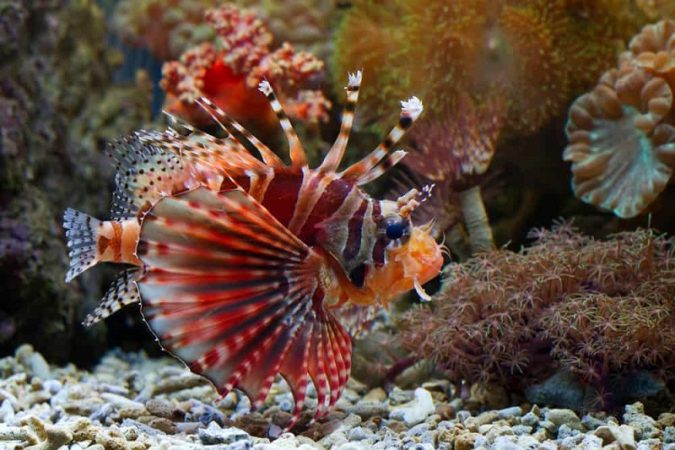
Dwarf lionfish has a broad distribution throughout the Indo-Pacific regions, from the eastern coast of Africa and the Red Sea down to South Africa and on to Samoa, the Philippines, and Australia. This species is also sometimes available as aquarium fish.
A 50-gallon aquarium or larger with a great number of hiding places is suitable for keeping a dwarf lionfish individual. During the time adapting to the new environment, the dwarf lionfish will need a place to hide from other fish.
In order to get a fish dwarf lionfish to eat when it is first introduced into the aquarium, you should use live saltwater feeder shrimp. Dwarf Lionfish typically eat meaty foods like live shrimp (including ornamental shrimp), live fish, and crustaceans.
Large angelfish
The large angelfish are one of the most popular angelfish varieties in saltwater aquariums. They typically eat microalgae, macroalgae, sponges, and zooplankton. Since angels of the same genus are usually more likely to fight when kept in the same aquarium, you should avoid keeping two same-species males in a tank.
Some of the large angelfish you can consider: Koran angelfish, Cortez angelfish, Emperor Angelfish, and Regal Angelfish.
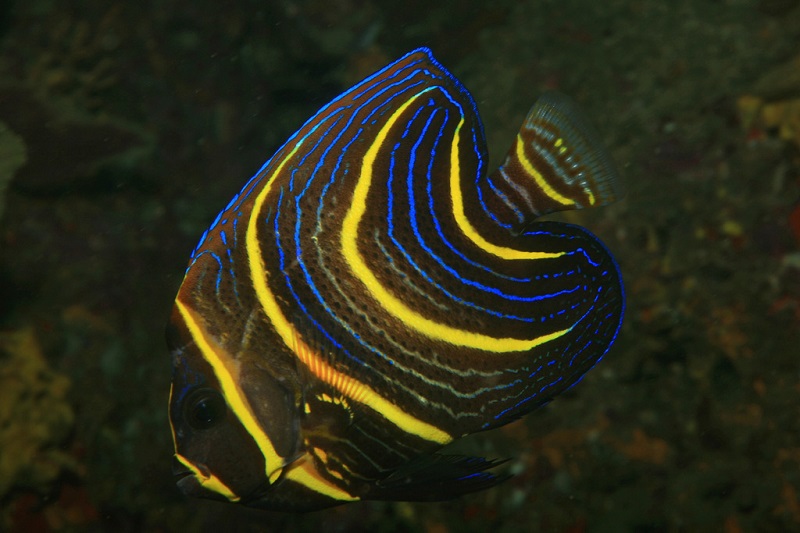
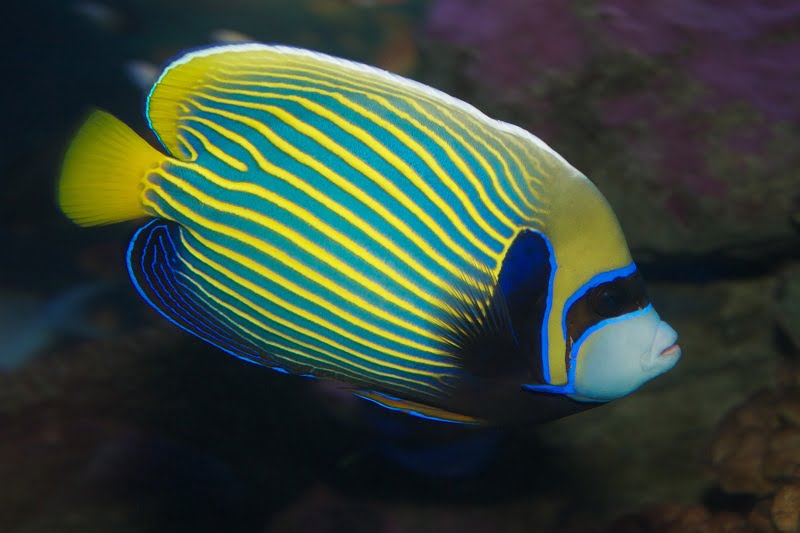
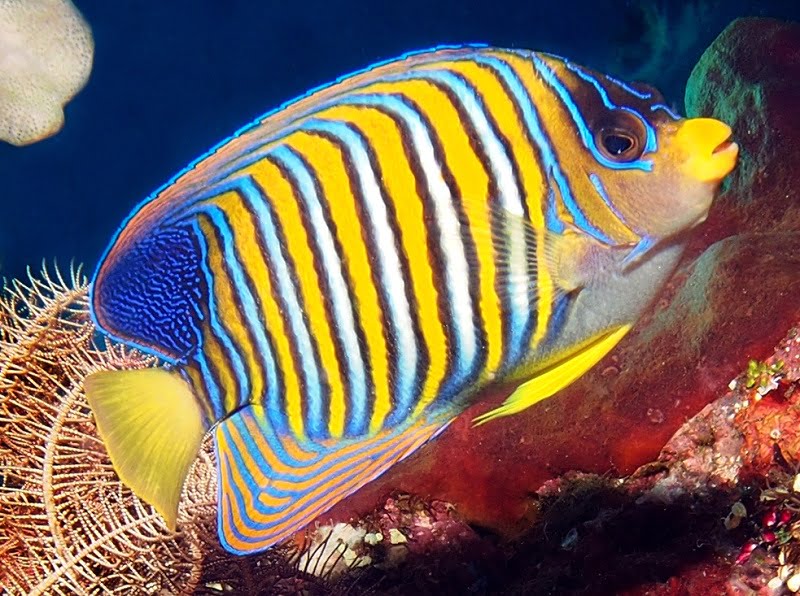
Adding a large marine angelfish to a well-established aquarium can make it even more spectacular. Considering they can grow quite large and be territorial, most species of these fish require a minimum of 100 gallons of live rock, although some species may require more.
Aggressive Tank Mates
Dottybacks
Dottybacks, or Pseudochromis, are mostly native to Indo-Pacific coral reefs. They have vivid coloration and a maximum size of 3 inches. Owing to their hardiness and beauty, adding dottybacks will make your reef or coral community aquariums lively and dazzling.
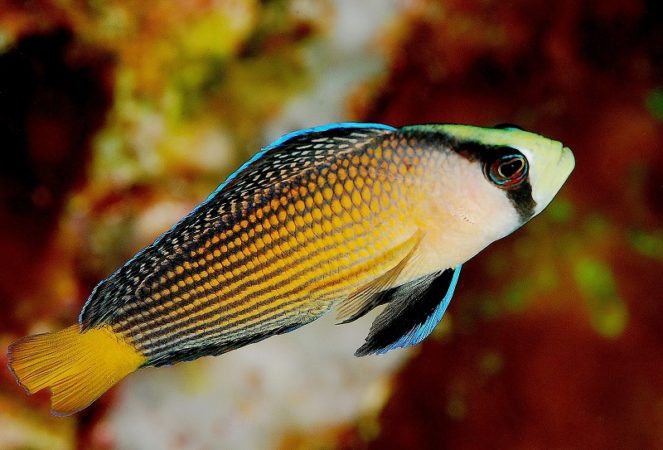
Though dottybacks have a relatively small size, they can be aggressive and territorial. Hence, it is critical to provide them with a cave or crevice among the décor to live in and defend.
They also do well in a reef tank with a great amount of rockwood and hiding places. You can feed your dottybacks with plankton, small crustaceans, worms, and most of the prepared foods.
Six-line wrasse
Pseudocheilinus hexataenia, also called Six-line wrasse or Six-stripe wrasse, are beautiful and active fish with a maximum size of 3.9 inches (10 cm). They can be found in the coral reef regions of the Indo-Pacific and the coast of Fiji.
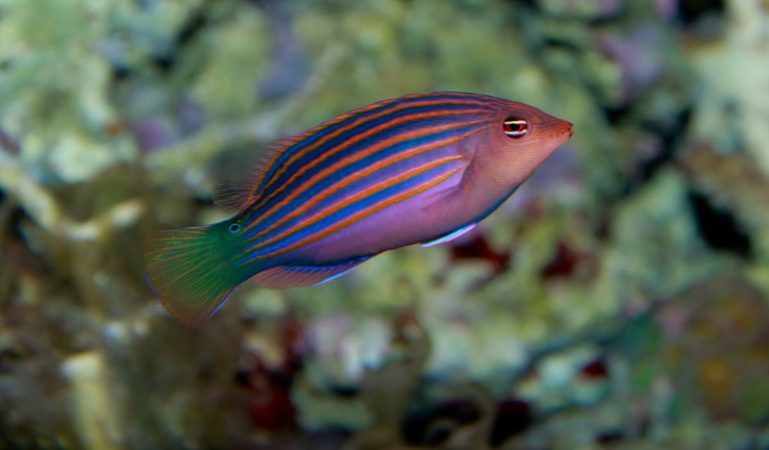
Many aquarists favor this fish species because it is hardy, disease-resistant, and has a long lifespan that can be up to 10 years. After being used to the tank environments, it can even help control some pests, like pyramidellid snails and commensal flatworms. In addition, they have been observed picking parasitic isopods and copepods from other fishes’ fins and bodies.
The six-line wrasses require a home aquarium with a minimum size of 30 gallons and numerous hiding places and live rocks to forage for food. They generally are peaceful but can behave aggressively towards other peaceful wrasses and easily-intimidated species.
Dietary sources for six-line wrasses must include vitamin-enhanced frozen mysis shrimp, brine shrimp, and other meaty foods along with marine flake and pellet foods.
Eight-line wrasse
Eight-line wrasses are benthopelagic species found among rubble or live corals of seaward reefs. Typically, this species is found at depths of at least 40 meters. As a carnivorous fish, its main diet consists of benthic crustaceans, sea urchins, fish eggs, and crab larvae.
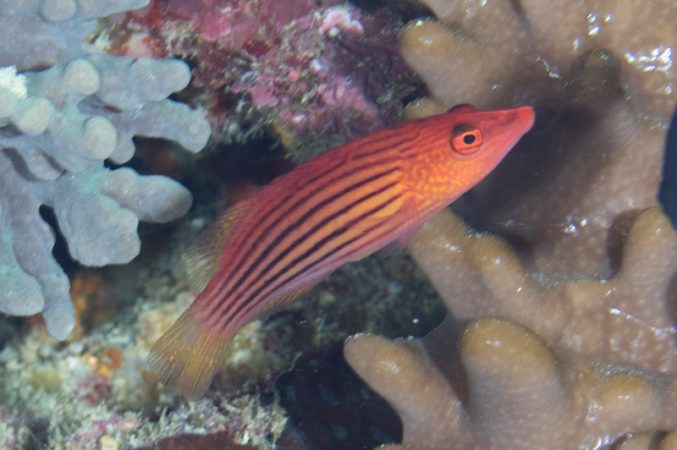
Not only an active and attractive fish, but the eight-line wrasse is also a hardy, disease-resistant, and long-lived species that is perfect for a saltwater aquarium. Besides, when in a reef tank, this fish will not likely harm corals or clams.
In a home aquarium, the eight-line wrasses will eat shrimp, crabs, gastropods, and even smaller fish. Moreover, they can help manage pyramidellid snails, bristle worms, small urchins, and commensal flatworms effectively.
These fish are timid in the wild but become boisterous in an aquarium once they get used to it. Typically, they do well in a community aquarium but can sometimes be aggressive towards shy and even larger fish. Besides, they do not get along well with other lined wrasse species.
This fish needs a minimum 30-gallon tank provided with many live rocks having numerous cracks and crevices to retreat, especially in a smaller tank setting.
Damselfish
Many Damsels are brightly colored, hardy, and small fish with a size of about 3.9 inches (10 cm), allowing them to fit into small aquariums. They are not picky eaters and can do well with other fish and invertebrates.
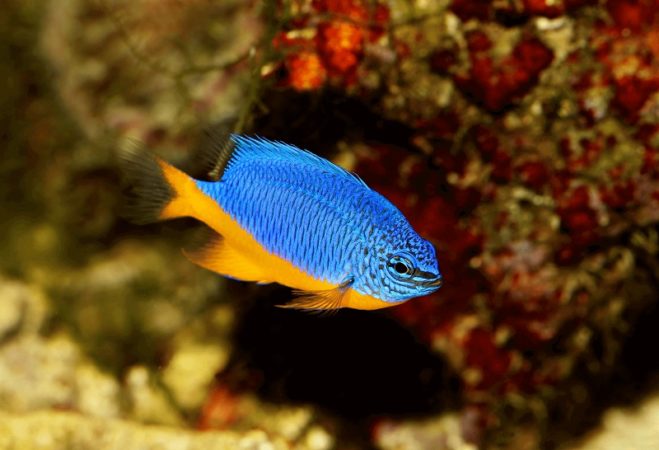
Damselfish are among the most popular aquarium fish and are often used for breaking into new aquariums and establishing nitrification processes. In order to do this, a fish needs around ten gallons of water.
The damselfish species are mostly from the subfamily Pomacentrinae which can be quite aggressive. They will display aggressive and territorial behavior towards other peaceful fish and even other damsels. If the tank is larger than 50 gallons or has a lot of hiding places, it is best to keep them individually. Also, they should be housed with more aggressive tankmates.
Tangs
Adult Tangs can reach a length of 15 cm to 40 cm (5.9 to 15.7 inches), and they grow very quickly even in aquaria. Therefore, you should consider the size of the tang before choosing one for your aquarium.
The tang species that are commonly added to the coral beauty angels’ tank include powder-blue tangs, royal blue tangs, and yellow tangs.
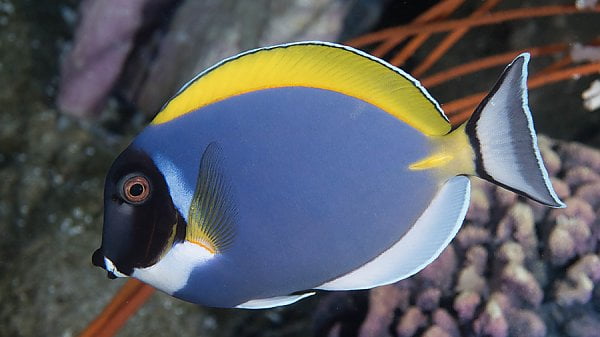
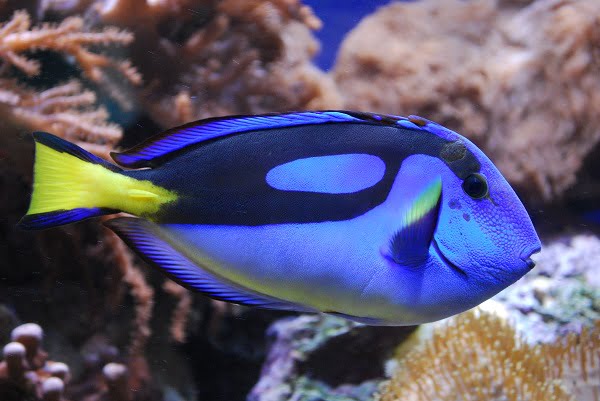
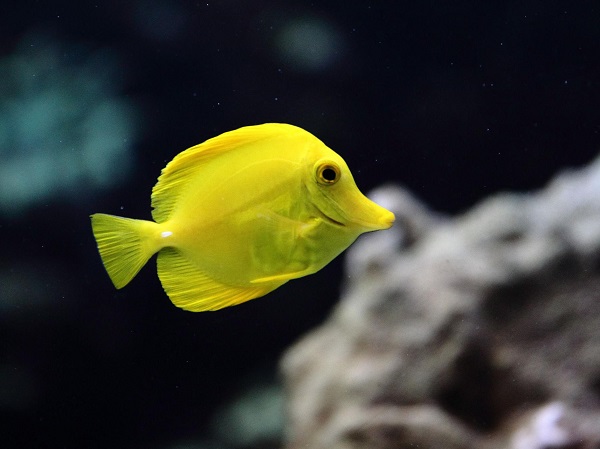
There are tang species that can grow up to 40 cm (16 in) in length, such as the Pacific blue tang surgeonfish, Naso or lipstick tang, lined surgeonfish, Sohal surgeonfish, and the Atlantic blue tang surgeonfish. These fish also require large swimming rooms.
As tangs are aggressive, territorial, and easily get into fights with other fish, adding them to your aquarium last is advisable.
The tang commonly feeds on macroalgae from genera such as Caulerpa and Gracilaria, but they have also been observed to consume meat-based fish food in an aquarium setting.
Notes For Keeping Coral Beauty With Their Tankmates
- All these marine fish can thrive in normal saltwater conditions, making them perfect coral beauty angelfish tank mates.
- When keeping coral beauty angelfish with large aggressive and predatory species, it is advisable to monitor them carefully. Also, it is best to choose the species of similar size to your coral beauty fish because larger predatory fish could eat your coral beauty.
- Besides, the coral beauty can display aggression towards other peaceful fish like gobies or dartfish; thus, you should prepare a larger tank to keep them safe. A tank of more than 55 gallons is often required in this case.
- Provide them with large tanks, numerous live rocks, and cavities where they can hide. Doing so will reduce aggression caused by overlapping territories.
- To maintain a stress-free and healthy community aquarium, you should make sure the water parameters are right and the quality is always good.
Video: Coral Beauty Angelfish In 90 Gallon Reef Tank (With Other Fish)
FAQs
Can I have 2 dwarf angelfish in the same tank?
The majority of angelfish species are not just a little bit ornery, but also mean, so keeping multiple dwarf angels together is only possible if conditions are favorable. If you intend to keep multiple dwarf angels in a tank under 110 gallons, all you will get is contentious chaos.
Thus, the first thing you should keep in mind for housing more dwarf angelfish together is preparing a large tank (>110 gallons) to provide plenty of swimming room for them.
Can I put a flame angel and coral beauty together?
You can put these two dwarf angels in the same tank, but it is best to introduce them to the tank together simultaneously.
If your coral beauty has been already in the tank and the flame angel is the lasted introduced fish, you may see them fight, chasing each other in the first few days. After that, everything will go back to normal.
Conclusion
The coral beauty angelfish can be kept with other fish species having peaceful to aggressive temperaments. This article has listed 13 most suitable coral beauty angelfish tank mates and some notes on keeping them together.
The importance of keeping them in harmony is to provide them with large tanks, many live rocks, and cavities for hiding places. This will help minimize the aggression caused by overlapped territory.
Remember to keep the water parameter on track for a stress-free and healthy community aquarium.

Annette M. Chaney is an experienced marine biologist with over 20 years of experience as an aquarist and fishkeeper. She started her first aquarium at a young age, filling it with frogs and goldfish obtained from the ten-cent pet store.
Annette grew up caring for and breeding African Cichlids, which led to a hobby in high school that doubled as a profitable means. Attending Reed College gave her time to solidify herself as an accomplished aquarium caretaker with an eye for sales. After that, from 2009 – 2013, she studied at Roger Williams University – one of the most prestigious universities for Aquaculture and Aquarium in USA. She is the founder of AquariumCircle since 2010.
